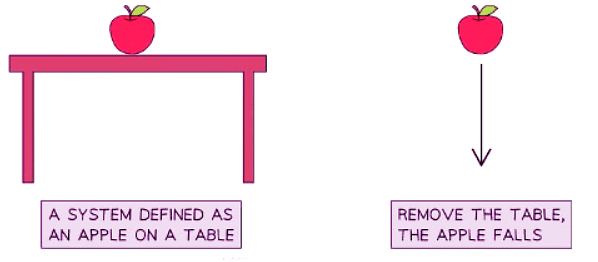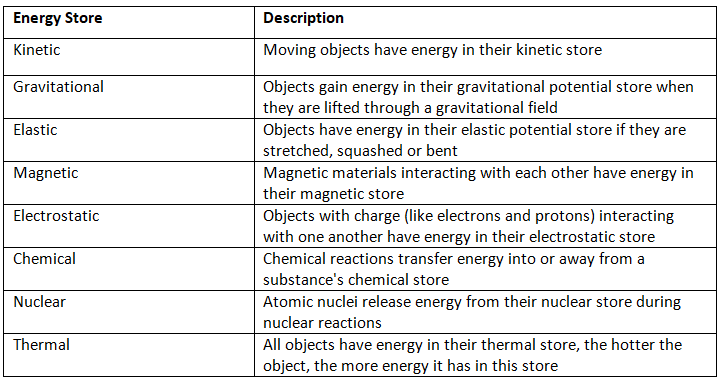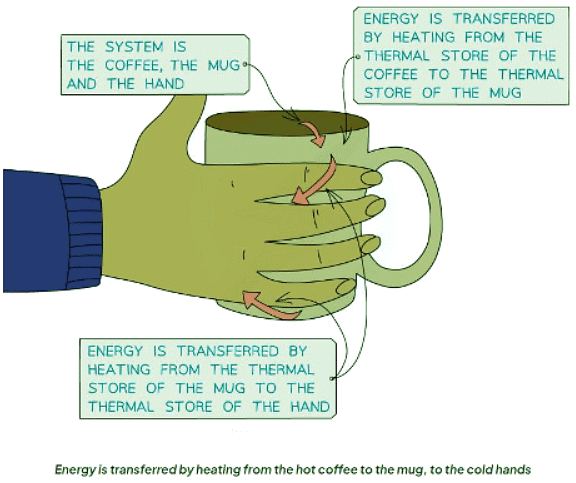Class 10 Exam > Class 10 Notes > Physics for GCSE/IGCSE > Energy Stores & Transfers
Energy Stores & Transfers | Physics for GCSE/IGCSE - Class 10 PDF Download
Energy Stores
- Energy is a quantity that needs to be transferred to an object to either perform work on it or increase its temperature.
- The unit of energy measurement is the joule (J).
- Energy is frequently discussed within the context of an energy system.
- In the realm of physics, a system is defined as an object or a collection of objects.
- In physics, delineating the system serves to narrow down the variables to focus solely on what is pertinent to the observed situation.
- A system can span from something as immense as the entire universe to something as diminutive as an apple resting on a table.
- When a system is in a state of equilibrium, there are no alterations, and consequently, no changes occur.
- Any modification to a system results in the transfer of energy.
Example Scenarios
- If an apple is placed on a table and the table is suddenly removed, the apple falls due to the disruption in equilibrium.
- As the apple falls, potential energy is converted into kinetic energy, illustrating energy transfer in action.
- Objects possess energy stored in various energy stores, such as gravitational potential energy or chemical energy.

Energy Stores Table

Question for Energy Stores & TransfersTry yourself: What is the unit of measurement for energy?View Solution
Energy Transfers
- Energy moves between different stores through various pathways of energy transfer, which encompass:
- Mechanical: Involves the physical movement of objects or substances, such as when a force is applied to an object causing it to move.
- Electrical: Entails the flow of electrical charge through a conductor, like the transmission of electricity through wires.
- Heating: Occurs when energy is transferred due to a temperature difference, typically resulting in the warming of an object or substance.
- Radiation: Involves the transmission of energy through electromagnetic waves, such as light or heat emitted by the Sun.
- These pathways of energy transfer facilitate the movement of energy between different stores, allowing for diverse forms of energy to be utilized and transformed.
Energy Transfer Pathways Table

- An instance of energy transfer through heating is when a hot coffee transfers heat to a mug and then to cold hands, resulting in a temperature change.

Question for Energy Stores & TransfersTry yourself: Which pathway of energy transfer involves the physical movement of objects or substances?View Solution
The document Energy Stores & Transfers | Physics for GCSE/IGCSE - Class 10 is a part of the Class 10 Course Physics for GCSE/IGCSE.
All you need of Class 10 at this link: Class 10
|
126 videos|182 docs|35 tests
|
FAQs on Energy Stores & Transfers - Physics for GCSE/IGCSE - Class 10
| 1. What are the different energy stores discussed in the article? |  |
Ans. The article discusses various energy stores such as kinetic energy, gravitational potential energy, elastic potential energy, thermal energy, chemical energy, and nuclear energy.
| 2. How do energy transfers take place between different energy stores? |  |
Ans. Energy transfers occur when energy is converted from one form to another, such as from kinetic energy to thermal energy when friction is present.
| 3. Can energy be created or destroyed according to the article? |  |
Ans. According to the article, energy cannot be created or destroyed, but it can be transferred from one store to another.
| 4. What are some examples of energy transfers in everyday life mentioned in the article? |  |
Ans. Examples of energy transfers in everyday life include the conversion of electrical energy to light and heat energy in a light bulb, and the conversion of chemical energy in food to kinetic energy in the human body.
| 5. How does understanding energy stores and transfers help in practical applications? |  |
Ans. Understanding energy stores and transfers is crucial for various practical applications such as designing efficient machines, improving energy conservation, and developing sustainable energy sources.
Related Searches















